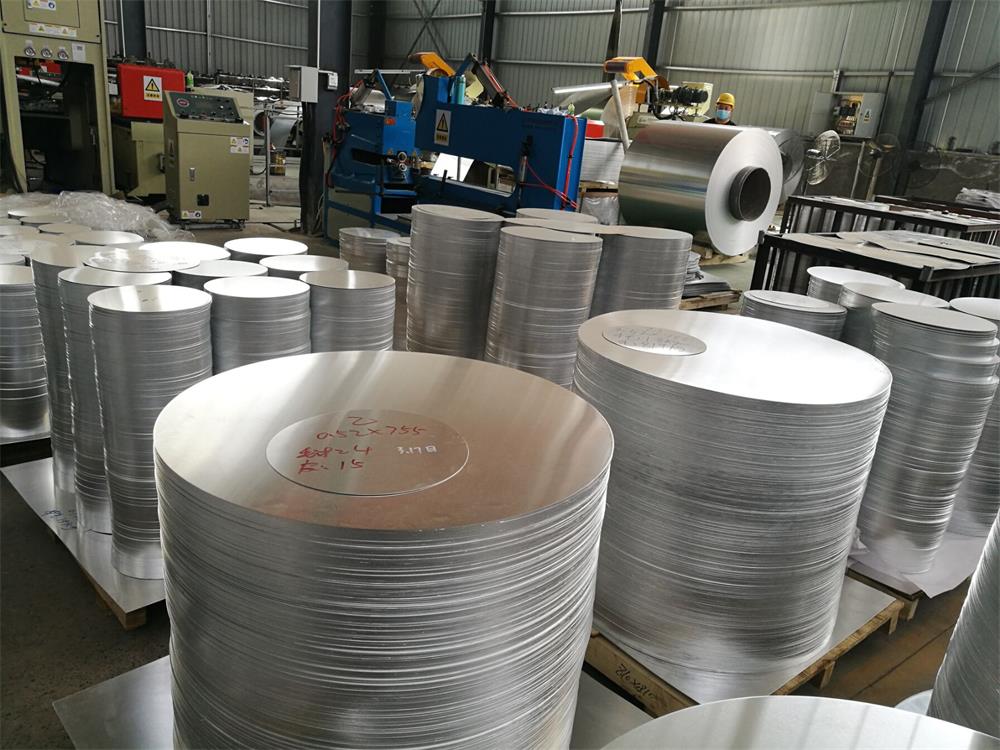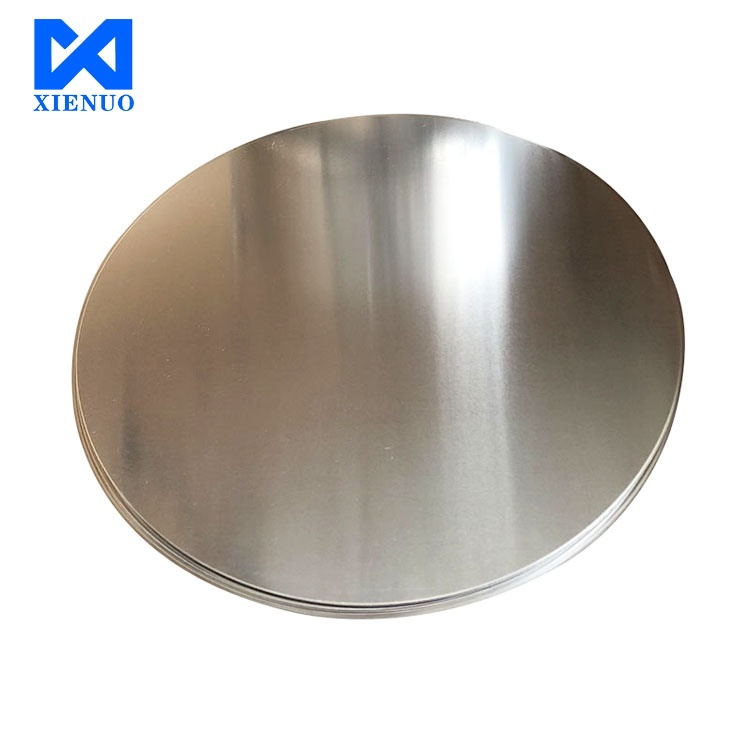
An aluminum disc is a circular-shaped piece or disk made from aluminum metal. It is typically manufactured through processes like casting, rolling, or stamping. Aluminum discs are used in various industries and applications due to their unique properties and versatility.
Henan Xienuo Enterprise Co., Ltd. is a modern aluminum processing enterprise mainly engaged in scientific research, processing, manufacturing, foreign trade import and export. 1-8 series of aluminum products include: aluminum discs, aluminum coils, aluminum sheets/strips, coated aluminum coils, curtain wall panels, aluminum foil, checkered panels, embossed color panels.
| Item | Aluminum Discs/Circles for Sale |
| Alloy | 1050, 1060, 1100, 3003, 3004, 5052, 5754, 8011 etc |
| Temper | O, H12, H14, H16, H18, H22, H24, H26, H28 |
| Thickness | 0.015″ – 0.24″ (0.4mm – 6mm) |
| Diameter | 3.15″ – 63″ (80mm -1600mm) |
We are a manufacturer of aluminum discs. The factory has advanced equipment and many years of aluminum manufacturing experience. Welcome to China to visit and consult with our aluminum disc manufacturing factory, and look forward to cooperating with you🤝!
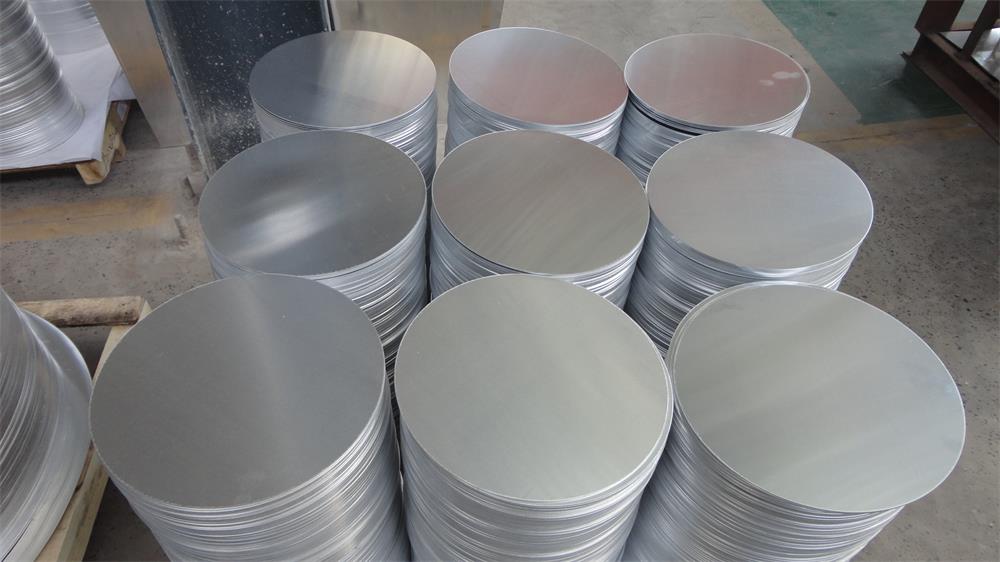
Characteristics of aluminum discs include:
- Lightweight: Aluminum discs are lightweight, making them easy to handle and ideal for applications where weight is a concern.
- Excellent Heat Conduction: Aluminum is an excellent heat conductor, allowing for even heat distribution and quick temperature changes, making it popular for use in cookware.
- Corrosion Resistance: Aluminum naturally forms a protective oxide layer, which provides excellent resistance to corrosion, making it suitable for outdoor and marine applications.
- Durable: Aluminum discs have high durability, making them long-lasting and capable of withstanding various environmental conditions.
- Electrical Conductivity: Aluminum is a good electrical conductor, making it suitable for electrical applications such as power transmission lines.
- Malleability: Aluminum is highly malleable, allowing for easy shaping and forming into different configurations.
- Recyclable: Aluminum is highly recyclable, which makes it an eco-friendly material choice and contributes to sustainable practices.
- Non-Toxic: Aluminum is non-toxic and safe for use in contact with food and beverages, making it a common choice for cookware and food packaging.
- Reflective: Aluminum has excellent reflectivity, making it suitable for applications requiring reflective surfaces, such as lighting fixtures and solar panels.
- Wide Range of Alloys: Aluminum discs can be made from various aluminum alloys, each offering unique properties suitable for specific applications.
These characteristics make aluminum discs a popular material choice in numerous industries, including automotive, aerospace, cookware manufacturing, electronics, and more. Their combination of lightness, durability, and resistance to corrosion makes them valuable components for a wide range of applications.
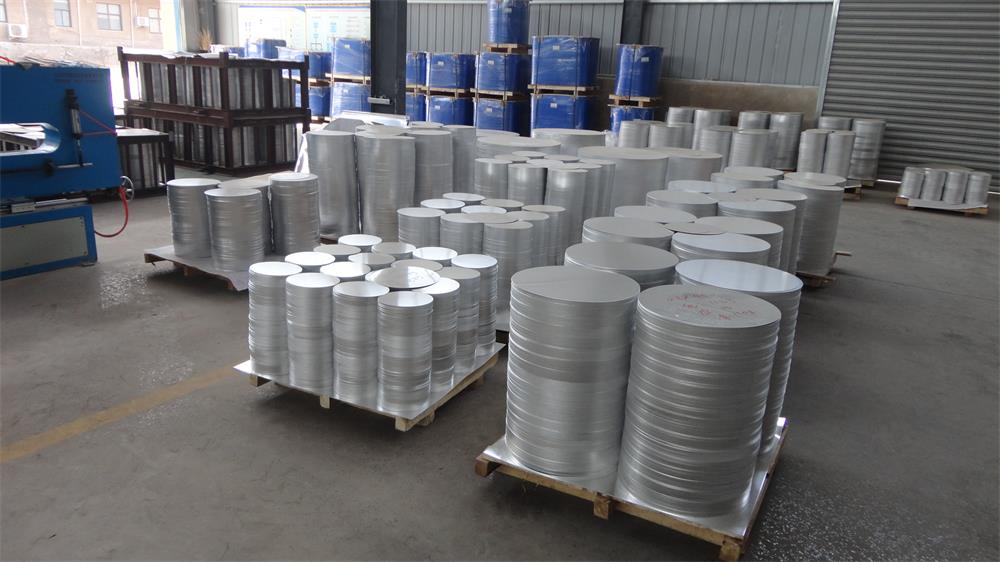
Production Process Of Aluminum Discs
The production process of aluminum discs involves several steps to convert raw aluminum material into the desired disc shape. The process may vary slightly depending on the specific application and manufacturing techniques used. Below is a detailed overview of the typical production process:
- Aluminum Ingot Preparation: The process starts with the preparation of aluminum ingots. These ingots are typically made from aluminum scrap or primary aluminum extracted from bauxite ore. The aluminum ingots are melted in a furnace to create a molten aluminum pool.
- Casting: The molten aluminum is then poured into molds or casts of the desired size and shape. These molds are often cylindrical to produce round aluminum discs. Alternatively, they may be designed for specific applications, such as cookware bases or automotive components.
- Cooling and Solidification: After casting, the molten aluminum inside the molds is allowed to cool and solidify. The cooling process can be natural or accelerated depending on the production requirements.
- Extraction from Molds: Once the aluminum has solidified, the molds are opened, and the aluminum discs are extracted. At this stage, the discs may have rough edges or surfaces, which need to be further processed.
- Hot Rolling (Optional): In some cases, hot rolling may be employed to further refine the aluminum discs. Hot rolling involves passing the aluminum discs through heated rollers, which help to achieve specific thickness and smoothness.
- Cold Rolling (Optional): Cold rolling is another optional step where the aluminum discs are passed through rollers at room temperature to achieve even greater precision in terms of thickness and flatness.
- Annealing (Optional): If the aluminum discs have undergone rolling processes, they may be annealed. Annealing involves heating the discs to a specific temperature and then gradually cooling them. This process helps to reduce internal stress and improve the material’s workability.
- Surface Treatment (Optional): Depending on the application, the aluminum discs may undergo surface treatments like polishing, anodizing, or coating to enhance their appearance, corrosion resistance, and durability.
- Cutting and Trimming: The aluminum discs are cut and trimmed to achieve the final desired dimensions and shape, removing any excess material or irregular edges.
- Quality Control: Throughout the production process, quality control checks are conducted to ensure the aluminum discs meet the required specifications and standards.
- Packaging and Distribution: Finally, the aluminum discs are packaged and prepared for distribution to various industries or manufacturers that will use them in their respective applications.
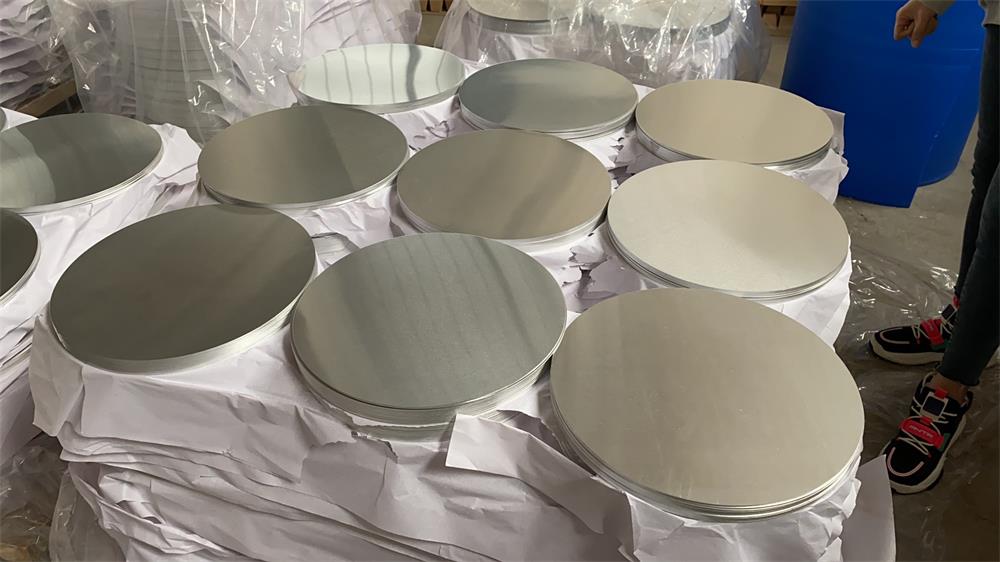
Applications Of Aluminum Discs
Aluminum discs have various applications due to their lightweight, durable, and non-corrosive properties. Here are ten different applications for aluminum discs:
- Cookware: Aluminum discs are commonly used as the base or core of cookware such as frying pans, pots, and baking sheets. The excellent heat conduction properties of aluminum ensure even cooking and quick temperature changes.
- Automotive Industry: Aluminum discs are utilized in the automotive sector for manufacturing lightweight parts, such as wheels, brake rotors, and engine components. This helps improve fuel efficiency and overall vehicle performance.
- Electrical Conductors: Aluminum discs are used in the production of electrical conductors due to their high conductivity and lightweight nature. They are often found in power transmission lines and electrical wiring.
- Nameplates and Labels: Aluminum discs can be used as nameplates and labels for various products, machinery, and equipment due to their durability and resistance to corrosion.
- Signage and Name Tags: Aluminum discs are commonly employed for creating durable and weather-resistant signage and name tags, suitable for both indoor and outdoor applications.
- Disk Drives: Aluminum discs serve as the base material for hard disk drives (HDDs) used in computers and data storage devices. They provide a stable platform for magnetic data storage.
- Art and Craft Projects: Aluminum discs are popular among artists and crafters for various creative projects such as jewelry making, embellishments, and DIY decorations due to their malleability and lightweight.
- Reflectors: Aluminum discs are used in reflectors for lighting fixtures, automotive headlights, and solar panels. They possess excellent reflectivity properties and help in directing light efficiently.
- Heat Sinks: Aluminum discs are commonly used as heat sinks in electronic devices to dissipate heat and prevent overheating of components like CPUs and LED lights.
- Bottle Caps and Closures: Aluminum discs are widely used as closures for bottles and containers, including beverage bottles, cosmetic products, and pharmaceuticals, due to their ease of sealing and resealing.
These are just a few examples of the numerous applications of aluminum discs across various industries and everyday products. The versatility and properties of aluminum make it a popular choice for a wide range of uses.
Factors Affecting the Price of Aluminum Discs/Circles
The price of aluminum discs can be influenced by several factors, including:
- Aluminum Market Demand and Supply: Fluctuations in demand and supply of aluminum in the market can have a significant impact on the price of aluminum discs. High demand or limited supply can lead to higher prices.
- Raw Material Costs: The cost of raw materials, particularly aluminum ingots used to manufacture discs, can directly affect the final price. Changes in the cost of bauxite (the primary source of aluminum) and other production inputs can influence pricing.
- Alloy Composition: Different aluminum alloys have varying costs due to the cost of alloying elements and their unique properties. Specialty alloys may be more expensive than standard ones.
- Energy Costs: Aluminum production requires significant energy consumption. Variations in energy prices can impact the overall cost of manufacturing aluminum discs.
- Currency Exchange Rates: For international transactions, fluctuations in currency exchange rates can affect the cost of imported aluminum and, consequently, the price of aluminum discs.
- Manufacturing and Processing Techniques: The method of manufacturing, including casting, rolling, or stamping, can affect production costs and, subsequently, the price of aluminum discs.
- Labor Costs: Labor expenses in the manufacturing process can contribute to the final price of aluminum discs. Labor costs can vary based on location and the complexity of the production process.
- Transportation Costs: Shipping and transportation expenses from the manufacturer to the buyer’s location can impact the final price.
- Market Competition: Competitive market conditions may drive manufacturers to adjust prices to attract customers.
- Regulatory Changes: Changes in trade policies, tariffs, or government regulations can influence the cost of aluminum and, consequently, the price of aluminum discs.
- End-Use Market: The specific industry or application where the aluminum discs are being used can also influence pricing. Industries with higher-value applications may be willing to pay more for specialized aluminum discs.
Overall, the price of aluminum discs is subject to the dynamic interplay of these factors and can vary over time. Understanding these reasons can help manufacturers, suppliers, and consumers anticipate price fluctuations and make informed decisions about purchasing aluminum discs.
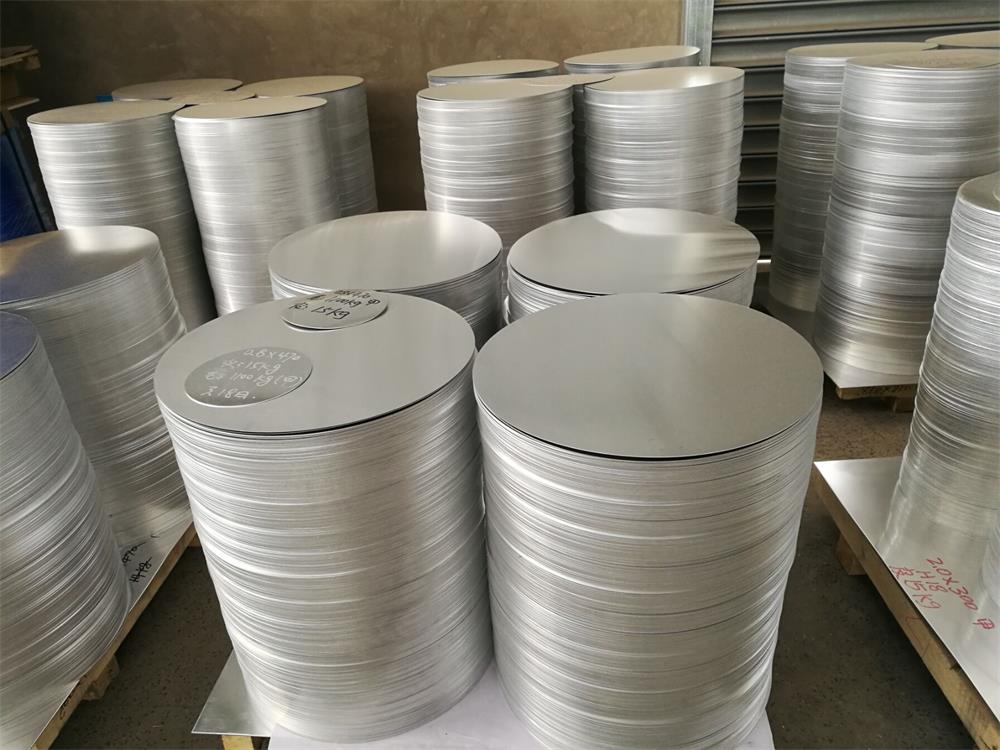
Properties of Aluminum Discs 1050, 1060, 1100, 3003, 3004, 5052, 5754, 8011
- 1050: Pure aluminum alloy with excellent formability and electrical conductivity. Suitable for cookware, electrical conductors, and signage applications.
- 1060: Pure aluminum with good formability and thermal conductivity. Used in cookware, heat sinks, and lighting industry for reflectors and lamp bases.
- 1100: High corrosion resistance and low strength. Ideal for chemical storage, food containers, and decorative items.
- 3003: High formability, good corrosion resistance, and moderate strength. Commonly used for cookware, heat exchangers, and chemical equipment.
- 3004: Good formability, corrosion resistance, weldability, and heat resistance, suitable for beverage can ends, automotive parts, food packaging, and chemical equipment.
- 5052: High strength, excellent corrosion resistance, and weldability. Suitable for marine applications, automotive parts, and electronic enclosures.
- 5754: Excellent corrosion resistance and high strength. Used in marine environments, transportation, and structural components.
- 8011: Good formability and high tensile strength. Ideal for food packaging, pharmaceuticals, and household foil applications.
In conclusion, aluminum discs are versatile and widely-used components with various attributes and characteristics that cater to diverse industrial applications. Each aluminum alloy, such as 1050, 1060, 1100, 3003, 5052, 5754, and 8011, possesses unique properties that make them suitable for specific uses.
Aluminum discs offer a balance of lightweight, corrosion resistance, formability, thermal and electrical conductivity, making them ideal for cookware, automotive components, electrical conductors, heat sinks, signage, and numerous other applications. The choice of a particular alloy depends on the specific requirements of the end-use industry.
Understanding the properties and uses of these aluminum discs allows manufacturers and consumers to make informed decisions, optimizing performance and efficiency in their respective applications. The continuing popularity of aluminum discs stems from their eco-friendly nature, recyclability, and non-toxicity, contributing to sustainable practices in various industries.
Overall, aluminum discs remain an integral part of modern engineering and manufacturing, continually driving innovation and providing reliable solutions for a wide array of industrial and consumer products. As technology advances and market demands evolve, aluminum discs are expected to maintain their significance as a valuable and adaptable material in diverse sectors worldwide.
